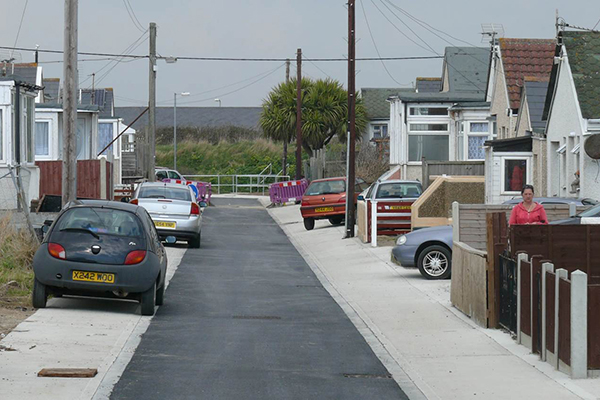You are viewing 1 of your 1 free articles
Coastal crisis: deprivation in Jaywick Sands
Living by the sea may be appealing but many communities face deep economic problems, says Caroline Thorpe. Photography by Press Association, History in Pictures and Getty
Just because a place has deprivation, it doesn’t mean it isn’t a nice place to live,” says Paul Price.
The view before our eyes suggests that Mr Price, corporate director at Tendring District Council, is onto something. Gentle autumn sunshine warms fine sand on the beach below our feet; the sea is calm.
Turn around, though, and there is the deprivation: rows of flimsy and impossibly small bungalows, some boarded up, others in better condition. An empty concrete lot stands where an amusement arcade buzzed in its long-forgotten heyday. Breeze blocks fill the windows of the Mermaid Inn, an erstwhile pub.
This is the contrasting world of the Brooklands neighbourhood in Jaywick Sands, a small town just west of Clacton on the south Essex coast. It is the most deprived neighbourhood in England, according to the government’s 2015 Index of Multiple Deprivation. It was also the setting for a recent Channel 5 reality show, Benefits by the Sea.
Mr Price – not a fan of the “unhelpful” show – is trying to turn the town around. “Lots of people have tried all the usual consultation schemes and developing masterplans, and none of it has worked,” he admits.
Deprivation drivers
Jaywick is far from the only coastal community with entrenched social and economic problems. Two recent studies highlighted that life is often tougher for those living by the sea, despite the scenery. In September, a study by the Social Market Foundation thinktank found that the economic gap between coastal and non-coastal communities was widening (see bullet points at the end of this article).
This followed a Housing & Finance Institute (HFI) report in May which identified a “toxic trio” of deprivation drivers common to coastal areas: an abnormally high proportion of rented housing, the low quality of those rentals and poor employment prospects.
The HFI went on to recommend housing-led measures to speed up the renewal of such places, including introducing a new “fair rents” regime. So what role can housing and social landlords play in tackling seaside deprivation, with or without taking on board the HFI’s suggestions?
“The council hadn’t banked on the strength of the community. They fought back.”
Back in Jaywick, Mr Price is detailing the decline of the community and a long history of failed attempts to revitalise it. Once a desirable spot for up-and-coming Londoners to have a holiday home, its fortunes began to change after World War II, he says. “People came to live here permanently, but the accommodation wasn’t suitable for that… there were no proper roads or sanitation.”
The council’s heavy-handed attempts to deal with the increasingly run-down area – which is also at risk of flooding – included the issue of 770 compulsory purchase orders in 1971. It came to nothing, says Mr Price, who is spearheading a housing-led approach to regeneration.
“The council hadn’t banked on the strength of the community and I think that’s something people haven’t really got to grips with [since]. They fought back.”
More recently “various iterations of masterplans” which failed to produce results alienated an already mistrustful community. “The feeling was that regeneration was being done to them. You were lucky if you didn’t get anything thrown at you when you went round and you were wearing a council badge,” reckons Mr Price.
When Mr Price arrived eight years ago, he found decline exacerbated by an influx of private landlords buying three homes compared to the price of one in nearby Colchester, but receiving rents at the same Local Housing Allowance rate. He estimates as many as two-thirds of the homes are now privately rented, many owned by landlords with little interest in maintaining the homes – a common factor in coastal communities.
“The feeling was that regeneration was being done to them. You were lucky if you didn’t get anything thrown at you when you went round and you were wearing a council badge.”
Perhaps the main barrier to change in Jaywick is again one shared by councils and social landlords seeking to regenerate any rundown coastal area: landownership. “This isn’t a social housing estate, it’s a private estate,” says Mr Price. In such situations, councils and social landlords find their hands largely tied.
Mr Price’s radical solution, begun four years ago, has been to persuade as many landowners in Jaywick Sands as possible to sell him their assets. The approach he describes is unorthodox – late-night meetings in car parks with shady characters included. But the result is 30 hectares of council-owned development land with potential for at least 940 new homes. The cost to the Housing Revenue Account? “Between £2m and £2.5m.”
Tendring has given itself planning permission for five Starter Homes and five council houses, all flood-proof and costing £117,000 each. Mr Price hopes to be on site at the end of the year, adding that the council “has had some discussions” with Legal & General (L&G) about the insurer locating an offsite manufacturing factory in Tendring. In theory such a facility could supply both Jaywick Sands and an Essex Council development outside Colchester – and provide local employment.
Tendring is also talking to another investor, Cheyne Capital Social Property Impact Fund, about possible development funding. Mr Price argues that L&G’s interest is a sign of increased confidence in Jaywick following council action.
Proposed private sector redevelopment at Jaywick Sands
Meanwhile an overseas developer, with local connections, has had plans approved for three blocks of flats by the sea. Mr Price sees change for the better: “House prices are rising. A property that was £28,000 18 months ago has just resold for £99,000.”
Around 240 miles to the north-west, 420-home Crosby Housing Association is laying the ground work for what chief executive Mandy Elliott hopes will be a brighter future for her residents in Crosby, Merseyside, around 70% of whom receive housing benefit.
“One of our aims is to regenerate the high street because we believe that’s the only source of employment for our tenants – entry-level jobs in service industries. Also they could walk to work, saving travel costs,” she says.
Regeneration aims
In October 2015 the association won a £10,000 government grant to set up a Coastal Communities Team (CCT), designed to help seaside areas plan for the future. Ms Elliott says the main benefit has been the doors the CCT has opened.
“Most of the team now have places on the [local council’s] strategic partnership. That was the best result we got out of the CCT: a place at the table to try and influence the council,” says Ms Elliott. “It’s got to be them leading because they own the coast and if we want anything strategic done on the coast, if we don’t make it important to them as part of their strategy then we can’t take it anywhere.”
Working with the council has also proved vital for 44,000-home Optivo, seeking to help communities on the East Sussex coast. Together with Hastings Council, the association has for the past five years run an initiative to overhaul rundown homes in the deprived St Leonards Ward in Hastings. “Tackling the poor quality private rented housing and replacing it with properties providing a range of tenures helps to regenerate an area,” argues Neill Tickle, land and new business director at Optivo.
To date 58 homes have been purchased and done up, with another 64 planned. The scheme has recently secured £660,000 in funding from the South East Local Enterprise Partnership for a further phase in Hastings.
As with other coastal schemes, the project has required innovation. “At inception [five years ago] the project was the first of its kind nationally to use the council’s borrowing powers from the Public Works Loan Board to ‘on lend’ to a housing association,” says Mr Tickle.
Resurfaced roads and new drains
Getting projects to stack up is the toughest challenge, he adds. “Finances on coastal schemes are difficult [because] the value of homes is limited, especially on refurbishment homes like those in Hastings we’re working on. Rent levels are low in Hastings and many other seaside towns because of the rundown nature of the area.
“Therefore you need a strong resolve, some innovation and a supportive board to get a scheme off the ground. We’ve had all of those things, but many providers don’t have this. Or perhaps there are easier schemes to deliver elsewhere that entice housing associations away.”
Enter the HFI. Its Turning the Tide report recommends structural changes “to build a faster, stronger, new coastal renaissance to reverse entrenched deprivation within years rather than decades”, says Natalie Elphicke, chief executive of the HFI.
These include a one-stop shop for housing renewal powers, streamlining the process whereby local authorities take action against poor quality homes. Ms Elphicke calls the suggestion “realistic”. “It would be cheaper and more effective for councils to lead change with a one-stop shop for housing market renewal rather than the current hotchpotch of powers.”
She would also like to see a new ‘fair rents regime’ applied to homes rented to Local Housing Allowance claimants, which “allows other factors, including the quality of the property, to be taken into account when setting the rent”.
Mr Tickle says any such approach “would need to be piloted to test for any unseen consequences”.
But will the HFI’s recommendations come to pass? Ms Elphicke believes ministers hold, “a serious commitment to considering suggestions to accelerate the reversal of entrenched deprivation in coastal and other communities. That has been our experience in discussions we have had with both ministers and officials.”
A spokesperson for the Department for Communities and Local Government says: “Evidence from Britain and around the world shows that capping or controlling rents can result in declining investment, leading to fewer properties on the market and higher rents as a result.” The HFI report states that its proposal is designed to avoid these outcomes.
Whether or not the HFI gets a positive result, Mr Price is remaining focused. “Jaywick Sands is number one on the indices. We can’t take our eye off the ball.”
Dilapidated properties in East Jaywick
Oh, I don’t like to be beside the seaside
- Half the 10 British local authorities with the highest unemployment rate in the year to March were coastal
- Economic output per head was 26% lower in coastal communities compared with non-coastal communities in 2015 (latest figures)
- Ten of the bottom 20 British local authorities for economic output are coastal communitie
- Five out of the 10 local authorities in Great Britain with the lowest average employee pay are coastal
- Residents in coastal areas have more health problems than those living elsewhere
- Seventy per cent of the small areas most affected by poor quality housing are coastal
Sources: Social Market Foundation, Housing & Finance Institute








